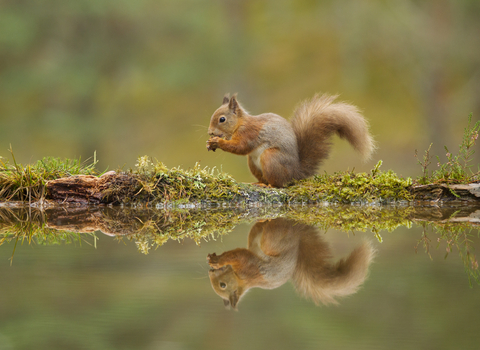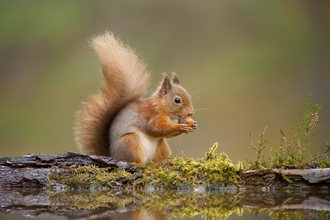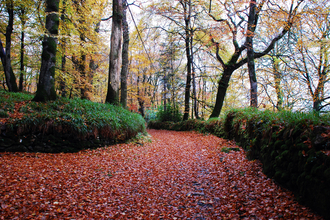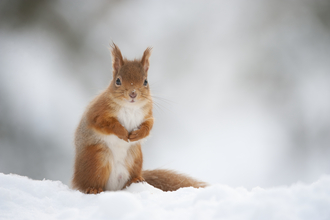Red squirrels
With their distinctive russet fur, tufted ears and twitching tail, a red squirrel is a captivating sight. Autumn is a great time to see them as they forage nuts to cache for the long winter months. The introduction of the grey squirrel from North America caused our once common native red squirrel to go on the retreat, disappearing from great swathes of the country. The total UK population is now thought to be as low as 120,000 animals, of which more than three quarters are found in Scotland.
Tune into the sights and sounds of the woodland and forest, listen for the squirrels’ distinctive chattering call and look out for the gnawed husks of pine cones both on the ground and raining down from above!
Find red squirrels near you
The introduction of the grey squirrel from North America caused our native red squirrel numbers to plummet, perhaps partly due to competition from the larger American, but also due to the ‘squirrel pox’ virus carried by the greys, which can cause entire populations of red squirrel to die out. Scotland and Ireland are where the red squirrel now has its main strongholds. In England, red squirrels only survive on the Isle of Wight and Brownsea Island, where there are no greys, on the Formby coast, and in the extensive pine forests of Northumberland and the Lake District. Things aren’t much better in Wales, although Anglesey has recently been declared grey squirrel free.
- Cumbria, Smardale Gill (a premier nature reserve for spotting reds)
- Cumbria, Wreay Wood
- Dorset, Brownsea Island nature reserve (a strong population of red squirrels; one of only two populations in southern England)
- Isles of Scilly, Tresco (they were introduced a number of years ago and are now breeding successfully)
- Isle of Wight, Bouldnor Forest (no introduced grey squirrels - reds thrive here)
- Merseyside, Freshfield Dune Heath (frequent sightings in the woodland)
- Northumberland, Hauxley (captured on trail cameras on a feeder near the visitor centre)
- Northumberland, East Cramlington Pond, Holystone North Wood, Holystone Burn
- Northumberland, Tony’s Patch (regular sightings)
- Northumberland, Juliet’s Wood, Briarwood Banks (both rare sightings)
- North Wales, Cors Goch
- Perthshire, Loch of the Lowes (a top spot for year-round close-up views, with specially designed squirrel feeder boxes and rope walkways set up in the woodland feeding station, within metres of a large observation window)
What to look for
Red Squirrels are most often found in coniferous woods, feasting on hazelnuts by cracking the shell in half. You may also find pine cones that have been nibbled, leaving what looks like an apple core behind. Squirrels make a rough nest, called a 'drey', of twigs, leaves and strips of bark in the fork of a branch, high in the tree canopy. Like most wild animals, red squirrels tend to be shy of people, so keep as quiet as you can. A good first place to look is on bird feeders! Red squirrels are just as keen on peanuts as their grey cousins, and they may come to feeders if they are around.
If you can’t get to these places
If you can’t get to the special places listed, The Wildlife Trusts are partners in red squirrel conservation projects in Scotland, mid Wales and northern England. Visit the project websites to find out more about this endearing threatened native.
More wildlife experiences
From seeing colourful wildflowers to spotting magnificent birds of prey, we can help you get closer to wildlife across the UK.








